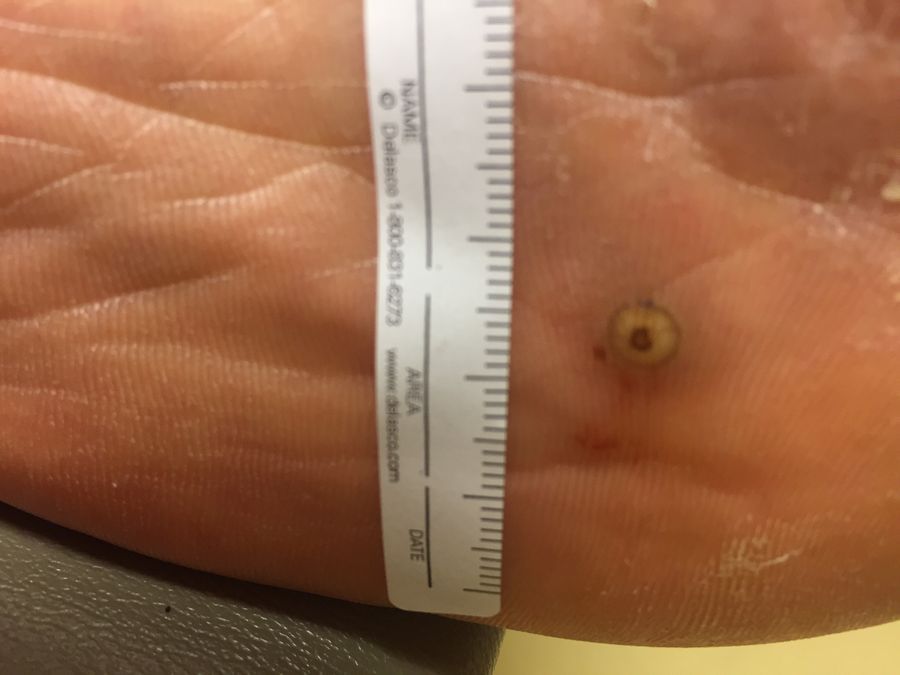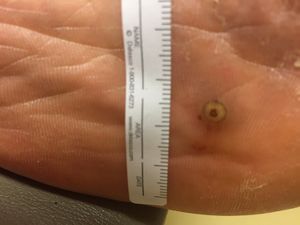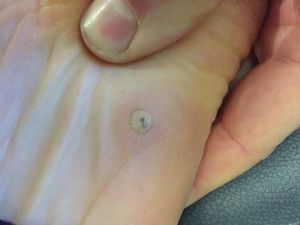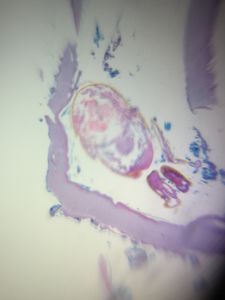Oh, what’s that growing inside my foot. Story of Tunga penetrans
 Dec 03, 2016 • 9:57 PM UTC
Dec 03, 2016 • 9:57 PM UTC Unknown Location
Unknown Location 140x Magnification
140x Magnification Microorganisms
Microorganisms
Manu Prakash
I am a faculty at Stanford and run the Prakash Lab at Department of Bioengineering at Stanford University. Foldscope community is at the heart of our Frugal Science movement - and I can not tell you how proud I am of this community and grassroots movement. Find our work here: http://prakashlab.stanford.edu
266posts
1192comments
42locations

When you cross through an airport security line; you are often asked if you are carrying any insects or plants. Knowingly, we are not carrying anything back – but what about biodiversity traveling back with you unknowingly. This is the story of Tunga penetrans; one of the smallest fleas that recently hitched a ride in my foot. Yes; I mean inside my foot.
I just returned from a recent field trip from Madagascar (Infanadina district), the trip revealed wonderful surprises; moths as large as my hands and mosquitoes of all kind. I hope everyone who participated will document the findings here; for the rest of the community to see.
Field notes from Madagascar – part 1
But today, I will tell this story from a very personal point of view. In tropical regions around the world; biodiversity has another unusual way for showing up – in your own body.
After returning from the trip; I noticed a mild pain in the bottom of my foot. I looked a couple of times but ignored it for a couple of weeks. Until one day; I noticed a strange pattern. Exactly under my foot was a perfect circular pattern (bulls eye) the size of a pea with a perfect black dot in the center. Here is an image of the same.
I just returned from a recent field trip from Madagascar (Infanadina district), the trip revealed wonderful surprises; moths as large as my hands and mosquitoes of all kind. I hope everyone who participated will document the findings here; for the rest of the community to see.
Field notes from Madagascar – part 1
But today, I will tell this story from a very personal point of view. In tropical regions around the world; biodiversity has another unusual way for showing up – in your own body.
After returning from the trip; I noticed a mild pain in the bottom of my foot. I looked a couple of times but ignored it for a couple of weeks. Until one day; I noticed a strange pattern. Exactly under my foot was a perfect circular pattern (bulls eye) the size of a pea with a perfect black dot in the center. Here is an image of the same.


Above: right foot, bottom.
I looked closely and also found another outgrowth on my third toe finger. But that was much smaller. The peculiar feature of this outgrowth was a tiny stiff needle sticking out of the center of the bulls eye. What raced in my mind was a “bot fly” although I knew this was not the pattern I would expect.
So I called friends, doctors with no real clues. A little bit of search on google images revealed “sand flea” infestation. Before I started imagining any further; it was time to talk to my Madagascar buddies (Thanks Sahara) and it was confirmed.
This was a signature infection of “ Tungiasis ” caused by a borrowed “sand flea” that penetrates the foot and starts enlarging almost 2000 times (in volume). As can be read in the link above; a very large group of people get affected every year – and places with 60-80% prevlance exists in specific locations.
The flea is less than 500 microns when it somehow jumps and penetrates human tissue (foot and hands) and makes a cozy home. It orients itself with the “butt” sticking out; most likely for breadthing. Remember, Arthropods need oxygen and it might not be present in enough concentration for this flea to survive inside a human host. Although, I don’t know when this thing called my foot a home; at this point this flea was in its full form making little babies (the swollen yellow zone) ready to lay the eggs anytime.
At this point, I decided to get it pulled out. I want to remind you that millions of people around the world don’t have the option of walking to a sterile surgical facility to just get them removed. Just leaving them alone has a high risk of bacterial infection which often become complicated. I could not find many papers on “non-surgical” treatment for Tungiasis; so if you find any relevant papers – please list them in comments below.
Methods: I got a punch biopsy in a sterile environment; where the entire parasite was removed intact. I got the tissue sliced into thin section and stained with H&E stains.
I used my Foldscope (140x) lens to image.
I ended up finding beautiful gems – living in my own foot. Since I had two samples; I was able to catch the flea in a “small” state and its enlarged state. These are cross sections; so you have to interpret what the shape of the parasite is. It’s also remarkable to watch your own samples – literally looking at your own tissue.
Foot 1: here you can view the entire “sand flea” almost intact with the legs and the body.
I looked closely and also found another outgrowth on my third toe finger. But that was much smaller. The peculiar feature of this outgrowth was a tiny stiff needle sticking out of the center of the bulls eye. What raced in my mind was a “bot fly” although I knew this was not the pattern I would expect.
So I called friends, doctors with no real clues. A little bit of search on google images revealed “sand flea” infestation. Before I started imagining any further; it was time to talk to my Madagascar buddies (Thanks Sahara) and it was confirmed.
This was a signature infection of “ Tungiasis ” caused by a borrowed “sand flea” that penetrates the foot and starts enlarging almost 2000 times (in volume). As can be read in the link above; a very large group of people get affected every year – and places with 60-80% prevlance exists in specific locations.
The flea is less than 500 microns when it somehow jumps and penetrates human tissue (foot and hands) and makes a cozy home. It orients itself with the “butt” sticking out; most likely for breadthing. Remember, Arthropods need oxygen and it might not be present in enough concentration for this flea to survive inside a human host. Although, I don’t know when this thing called my foot a home; at this point this flea was in its full form making little babies (the swollen yellow zone) ready to lay the eggs anytime.
At this point, I decided to get it pulled out. I want to remind you that millions of people around the world don’t have the option of walking to a sterile surgical facility to just get them removed. Just leaving them alone has a high risk of bacterial infection which often become complicated. I could not find many papers on “non-surgical” treatment for Tungiasis; so if you find any relevant papers – please list them in comments below.
Methods: I got a punch biopsy in a sterile environment; where the entire parasite was removed intact. I got the tissue sliced into thin section and stained with H&E stains.
I used my Foldscope (140x) lens to image.
I ended up finding beautiful gems – living in my own foot. Since I had two samples; I was able to catch the flea in a “small” state and its enlarged state. These are cross sections; so you have to interpret what the shape of the parasite is. It’s also remarkable to watch your own samples – literally looking at your own tissue.
Foot 1: here you can view the entire “sand flea” almost intact with the legs and the body.




Not only can you see the insect exoskeleton completely embedded in the tissue; the inner muscles and tissue of the sand flea are also quiet visible. I wish I had preserved more cross-sections; but I will figure out a way to slice them differently next time.
Foot 2: mature sand flea ready to lay eggs.
Foot 2: mature sand flea ready to lay eggs.








In the above pictures; a very different view of the parasite is visible; a cross section through the belly which is filled in several places with tiny eggs. Those would be the embryos that the flea would lay after maturation. It’s not clear how the life cycle of Tungiasis works and what is the exact moment of fertilization for the female flea to be ready to actually lay eggs. Whatever the case; I am glad I did not give this little flea a chance to make my foot it’s permanent home.
The story does not end here; since I was able to get some more samples from a friends foot as well. This gets me two more samples with more stains to try. If you have a suggested stain or viewpoint you would like me to image in next round of the parasite; please make suggestions in comments below.
Attached is a picture of my slides. In a future post; I will share a more anatomical viewpoint into my own foot; and share images of regions with no parasites.
The story does not end here; since I was able to get some more samples from a friends foot as well. This gets me two more samples with more stains to try. If you have a suggested stain or viewpoint you would like me to image in next round of the parasite; please make suggestions in comments below.
Attached is a picture of my slides. In a future post; I will share a more anatomical viewpoint into my own foot; and share images of regions with no parasites.

Until next time; get out but also keep a close eye on what’s around. Who knows what’s living inside us at this very moment.
Cheers
Manu
Ps: this is just my personal documentation of my experience with Tungiasis. You should consult medical professionals and get advice for handling the disease.
Cheers
Manu
Ps: this is just my personal documentation of my experience with Tungiasis. You should consult medical professionals and get advice for handling the disease.
Sign in to commentNobody has commented yet... Share your thoughts with the author and start the discussion!

 0 Applause
0 Applause 0 Comments
0 Comments
















